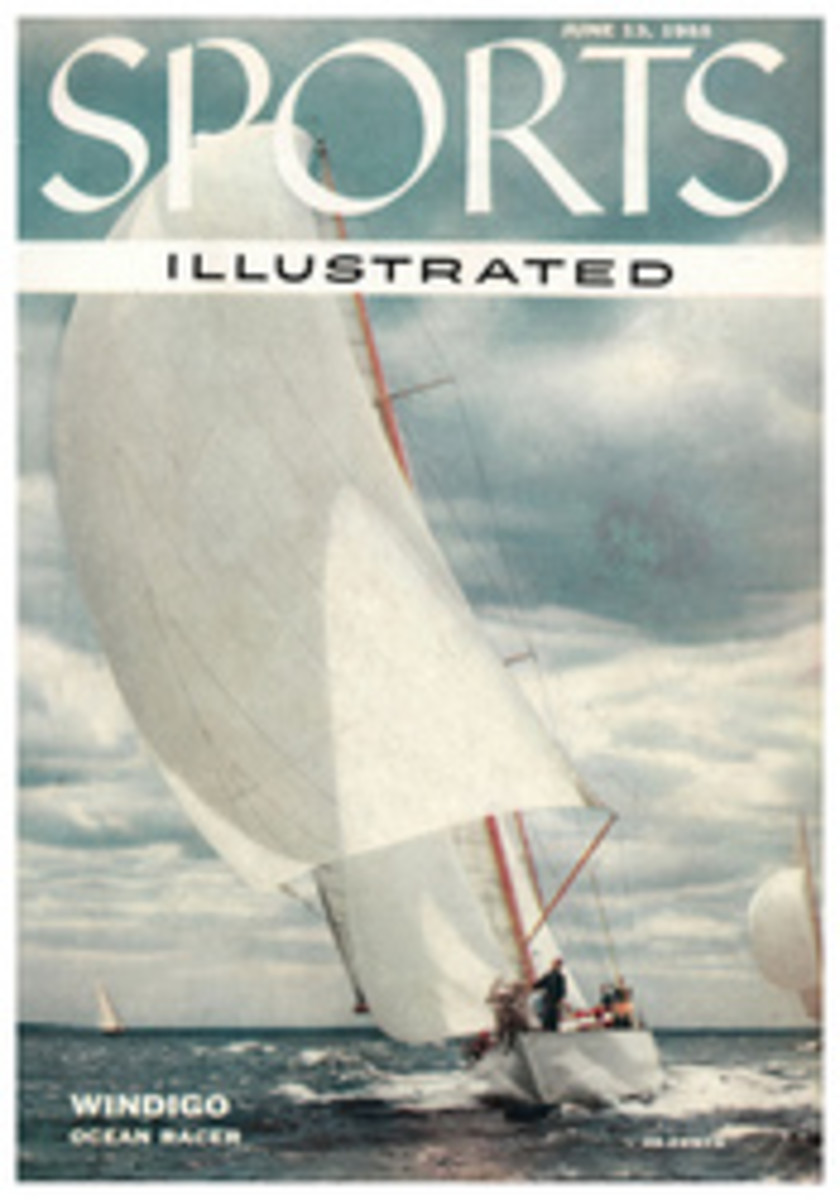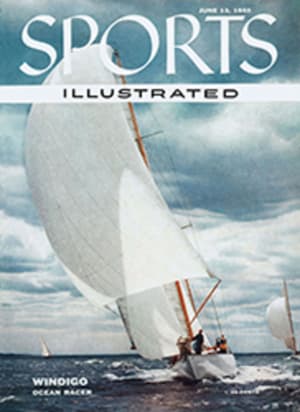
QUEENS OF THE DEEP WATER
To anyone who has raced on the deep water, there is no more beautiful or more discouraging sight than James Michael's black-hulled Baruna charging to windward (left), or the trim Hoot Mon (right) skimming to leeward, her red-orange spinnaker reaching out to catch every breath of air. For each of these racing queens is virtually unbeatable at her specialty. Last winter, in the Caribbean, Hoot Mon won both the Miami-Nassau and St. Petersburg-Havana races in a successful defense of her southern circuit championship (SI, March 28) and Baruna, already an acknowledged mistress of major fixtures like the Bermuda race, is a prime favorite in the July 4th dash to Honolulu.
Another favorite with a reputation for speed is Carl Hovgard's proud Circe (next page), considered the hottest of the entries in the 3,450-mile race to Sweden starting this week off Newport, R.I. Fortunately for the competition, these boats can enter only one race at a time, and in a season so busy that a yachtsman who cared to could race every week, there will be more than enough honors to go round. For example, a day after Circe and Co. head for Sweden, another squadron of ocean racers will leave Havana headed for San Sebastian, Spain. However, the entrants in the San Sebastian event will get only one race for their money. Up north the calendar is crowded. For this is the year of the 125th anniversary of the Royal Swedish Yacht Club, and at least 13 American boats are going to Sweden to take part in the two-week-long anniversary regatta.
Circe, of course, will race over, heading up the first competition across the north Atlantic in 20 years. Sailing against her will be Richard Nye's brand-new Carina, which was built in Germany and rushed to New York by steamer last week. Four German boats—Peter von Danzig, skippered by Rolf Dehning of Kiel; the Schl√ºssel von Bremen, sailed by Rudolph Koppenhagen of Bremen; Willy Bruns' 56-foot Kormoran from Hamburg; Ortac, a 49-foot sloop owned by the Hamburg Ocean Racing Club—and the 47-foot ketch Stavanger from Norway will join the Americans in the long transatlantic race. Most of the other U.S. boats, including the 71-foot Windigo (see cover), will be shipped over on freighters.
The summer will be just as busy for American yachtsmen who stay at home. Only six days after the San Sebastian race begins, some 30 boats will start from New London bound for Annapolis. On July 2 there is a race from Gulfport, Miss, to Pensacola. Two days later the Honolulu race begins; and so it goes through the entire season.
This whirl of activity is quite a contrast to the quiet seasons from 1900 to 1920 when there was barely one real ocean race a year; and until the revival of the Bermuda race in 1923 the owners of deep-water sailboats were pretty much confined to cruising. The few boats that did compete in those days bore little resemblance to the crack racers of today. Heavy, broad-beamed and slow, they were patterned after commercial fishing schooners. One of the early exceptions was my father's 59-foot yawl Memory, which had started life as a day-racing sloop of the New York 40 class. Dad put a Marconi rig in her—the first such rig to race offshore—and was first to finish the 1923 Bermuda race. He duplicated this feat in the 1924 event, and beat the entire fleet on corrected time besides.
Incidentally, the equalizing effect of this handicapping device called corrected time has had a great deal to do with the continued popularity of ocean racing. Generally speaking, length is the major governing factor in a sailing boat's speed, a good big boat being faster than a good little boat. Another key to speed is the type of rig, i.e., a yawl or cutter is faster than a schooner on most points of sailing. There are many other factors—like beam, sail area, total displacement, etc. Therefore, without some sort of time allowance, a handful of boats might win all the races.
Corrected time prevents this by giving each boat a rating which allows her a certain number of seconds per mile of the course compared to another boat of a higher rating. If she finishes within this allowance she has done a better job, deserves to be declared the winner. For instance, in the 1951 Honolulu race, Richard Rheem's 96-foot schooner Morning Star was the first boat to finish. But after corrected times were computed the tiny Sea Witch, a 36-foot ketch that sailed a fine race for her size but finished 3 days, 22 hours behind Morning Star, was declared the winner. Morning Star dropped to 19th.
Not long after my father's boat established her reputation, a group of new contenders, designed and built specifically for ocean racing, began to appear. One early winner was the graceful and still-fast schooner Niña, which made her debut in 1928. In 1930 the Stephens brothers' Dorade was built, the first truly modern ocean racer. Only 52 feet long, she was yawl-rigged and deep and narrow in beam.
Then came Stormy Weather—winner of the last north Atlantic race in 1935—Escapade, Baruna and a long list of other champions down to the ultramodern Hoot Mon.
In the search for speed, however, the skippers of these ocean racers have not sacrificed comfort. The modern deep-water contender has comfortable sleeping accommodations, spacious galleys and roomy quarters in the main cabin. All have toilet rooms. Many have hot-water showers. All have iceboxes. Even fireplaces are not unusual. And there is an abundance of storage space and lockers fitted into their sleek hulls to enable the crews to carry food, stores, clothing, spare parts and extra sails so that the boat, once it leaves the dock, is completely self-sufficient.
These wonderfully complete boats are as well suited to quiet vacations as they are to transocean racing. And, in fact, as soon as the big races are finished, most of the sailors in Honolulu, Sweden, and San Sebastian will relax to do some leisurely cruising. For above all an ocean racer is built for pleasure, and the deepest pleasure comes not so much from winning as from being on the sea, aboard a real thoroughbred that will carry her crew to any port their will directs.
PHOTO
ED NELSON
"BARUNA" (left), 72-foot yawl owned by James Michael of Belvedere, Calif., was Bermuda champion in 1938 and '48. She is a favorite in Los Angeles-Honolulu race.
PHOTO
ALLAN GOULD
"HOOT MON" (right), 39-footer skippered by Lockwood Pirie of Chicago, won St. Petersburg-Havana race to take southern circuit title for second straight year.
PHOTO
MORRIS ROSENFELD
"CIRCE," owned by Carl Hovgard of Rye, N.Y., is dangerous competitor on spinnaker run (above) or on a beat to windward. A top placer in Bermuda race, Circe's fast hull and efficient yawl rig give her relatively high handicap. Nevertheless, she is considered the boat to beat in the ocean race to Sweden starting this week from Newport, R.I.
ILLUSTRATION
SLOOP
ILLUSTRATION
CUTTER
ILLUSTRATION
YAWL
ILLUSTRATION
KETCH
ILLUSTRATION
SCHOONER

